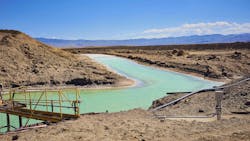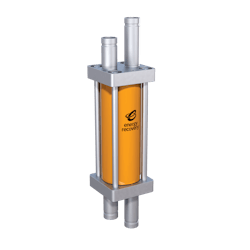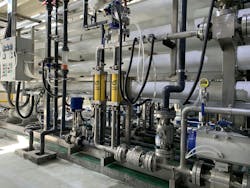Energy-saving solutions for sustainable lithium and battery production
Demand for lithium batteries is expected to rise fivefold by 2030 with the growth of electrification, especially for vehicles. Extracting and processing this key element has high energy requirements, which in many cases can be significantly reduced using reverse osmosis (RO) with energy recovery devices (ERDs).
Recovering lithium has different resource, cost and energy challenges depending on whether it is mined from ore or brine, primarily concentrated in remote regions of countries like Australia, Chile and Argentina. The process of extracting lithium from geologic brines historically involved pumping brine up to the surface to a series of evaporation ponds and waiting months for the water to evaporate and leave behind precipitated salts, which eventually yields a lithium salt. With the introduction of RO, the salt can easily be separated from the brine in a shorter amount of time with high purity. The use of ERDs in this process significantly helps reduce energy consumption. For direct lithium extraction projects and some evaporation pond sites, RO with energy recovery has reduced water and energy consumption while, in some cases, reducing processing time and improving the quality of lithium salts recovered.
Like brine mining, battery manufacturing has unique wastewater treatment opportunities, where RO can decrease the energy consumption of recovering nutrients and water for reuse. Some battery recycling projects yield dilute solutions of lithium, cobalt and nickel, which can be concentrated separately but using the same RO with an energy recovery device to reduce energy and cost to recover these minerals for new batteries. For example, Energy Recovery's PX Pressure Exchanger for low, high and ultra-high-pressure RO (UHPRO) can improve the sustainability of lithium processing while also recovering resources from waste streams, reducing liquid waste discharge and alleviating the environmental impacts on surrounding water bodies.
Energy-efficient solutions for lithium brine mining
Lithium is often extracted from brines using evaporation ponds, which have long production times of more than 12 months and recover only a portion of the lithium. Energy recovery devices paired with RO can separate lithium from brine while increasing lithium retention and saving energy when utilizing pressure exchanger technology. The PX is an energy recovery device that works by efficiently capturing pressure energy (typically >93% efficiency)* of the wastewater stream and recycling it back into the system, lowering the amount of energy needed to pressurize the wastewater feed stream. Energy Recovery’s suite of PX devices used with RO can be applied in some lithium brine mining sites — especially direct lithium extraction (DLE) sites for increased production, improved purity and reduced energy use.
ERD solutions successfully halved the amount of electricity* needed in a five-stage low salt rejection RO (LSSRO) and nanofiltration (NF) process to refine and concentrate lithium salts at the Zabuye Salt Lake in Tibet, which previously only utilized evaporation ponds. LSRRO is a process capable of highly concentrating brine with moderate to low operating pressures and involves multiple steps to concentrate the brine. Because of the number of stages in the process, the PX can significantly reduce the pump feed flow and thus reduce the pump's energy requirements. It does so by recovering the pressure energy of the brine stream and redirecting the energy back into the system for use. Because of the brine’s low magnesium-to-lithium ratios, the LSSRO nanofiltration process was able to double the production of lithium carbonate by reducing the evaporation time by half, while also polishing out unwanted salts to improve purity of the lithium carbonate product. The lithium carbonate can then be used to produce lithium iron phosphate (LFP) and other types of batteries.
When magnesium-to-lithium concentration is high, novel DLE technologies paired with the membranes and the PX can work in conjunction to decrease the energy needed to extract, concentrate and convert lithium chloride into high-purity battery-grade inputs. DLE involves processes such as ion exchange or resins to separate lithium from magnesium and other salts in mixed brines. The lithium chloride that comes out of many DLE processes is often dilute enough for membrane processes such as nanofiltration, low-pressure RO (LPRO), seawater RO (SWRO) and/or ultra high-pressure RO to significantly reduce the energy needed for concentration. When paired with high-efficiency ERDs, such as the PX, the membrane systems can reduce energy by 4 to 8 times what would be needed using mechanical evaporation. In the Qinghai province of Central China, the concentration of lithium chloride after DLE was achieved using multiple stages of electrically driven LPRO, SWRO and UHPRO. The use of recently launched PX U40s in the ultra-high-pressure step was able to not only reduce operating costs and energy, but also saved significant amount of space and investment costs that otherwise would have been needed to install massive new thermally driven evaporators in a remote, arid region of China.*
In both cases, PX technology had a rapid payback of less than two years for the lithium extraction companies, who also benefited from significant energy and cost savings over the 25-year design life of the PX.** As the demand for lithium increases, many brine mining operations, including both DLE and non-DLE sites, can use RO systems with ERDs to increase production, improve purity and reduce energy use.
Achieving ZLD for lithium batteries
As discharge regulations become more stringent, reducing the environmental impact of lithium battery manufacturing while recovering resources is important for battery manufacturing facilities. Energy Recovery has worked with more than 10 lithium iron phosphate (LFP) cathode manufacturing facilities in China. One example is an LFP facility in the Hubei province of China, which produces 50,000 tons of LFP cathodes per year. The designers of the wastewater treatment system for that plant utilized RO and UHPRO with PX technology to improve energy efficiency and reduce waste valorization costs. A combination of PX 140 and PX U40 on the RO systems implemented after pretreatment and LPRO successfully reduced the flow rate by 90% before the thermal process in the facility.* The facility now sells the remaining solids as a valuable ammonium sulfate fertilizer, and the income from the fertilizer covers the cost of the zero liquid discharge (ZLD) wastewater valorization process.
This approach served as a model for other facilities that copied this novel energy saving and waste valorization strategy, which has the added benefit of keeping this nutrient-rich wastewater out of the local water sources and surrounding environment. As the demand for LFP batteries continues to increase, ERDs can help reduce the cost of ZLD, water reuse and waste valorization to improve sustainability at battery manufacturing facilities. Based on this success, manufacturers of nickel-based lithium-ion cathodes are pilot testing a similar ZLD approach to recover and sell sodium sulfate as a byproduct of NCM (nickel cobalt manganese) cathode manufacturing.
Energy Recovery's full suite of solutions, from low to ultra-high-pressure PX devices, allows lithium extraction facilities to address significant barriers along the manufacturing chain by speeding up production, increasing waste valorization with ZLD, and reducing energy requirements.
*Actual results may vary
**Based on ERII testing
Eric Kadaj, is the senior director of market and application development at Energy Recovery.
Erik Desormeaux is the director of application development at Energy Recovery.
References
Desormeaux, E., Zhan, X., & Kadaj, E. (2018). IDA Seville Summit on Water and Climate. In Reducing Energy Use and Costs of Zero Liquid Discharge for Lithium Brine Mining, Battery Manufacturing, and Battery Recycling. Seville; The International Association Desalination.
About the Author
Eric Kadaj
Senior director of market and applications development at Energy Recovery
Eric Kadaj is the senior director of market and applications development at Energy Recovery. For more than 20 years, Eric has applied his engineering and technical expertise to drive greater sustainability within desalination and the industrial wastewater space, including process design and implementation, operational strategies and novel discoveries that minimize environmental impacts.


